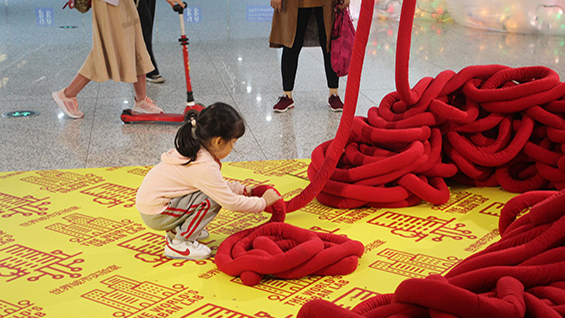CU Architecture Graduates Exhibit Instant Lounge at the 2019 Shenzhen Biennale
POSTED ON: January 21, 2020
Gabriel Munnich, Yaoyi Fan, Pablo Toubes-Rieger, and Leslie Dougrou, a group of four 2018 graduates of The Irwin S. Chanin School of Architecture, have come together to form UEO Design, a collective of inventors, designers, artists, and architects located in both New York City and Zhuhai, China. UEO—Urbi et Orbi (To the City, To the World)—builds apps, machines, installations, and architecture. For the 2019 Shenzhen Bi-City Biennale of Urbanism/Architecture, the group challenged itself to design environmentally-conscious, instant furniture for public spaces that can be configured for the immediate needs of a space at any time of day. Using a cable machine and thick, soft rope, UEO devised a system that generates numerous furniture configurations, each of which can be retracted and replaced when another configuration is desired. This highly original design offers flexible use through minimal means and modest materials.
Project Description:
In an urban context, the flux of people constantly redefines public space throughout the day. How can digital fabrication address this impermanence? What if public space could identify the sitting and lounging needs of pedestrians throughout the day to provide instant furniture? A train station platform or an airport terminal, for example, can be empty during rush hours to allow for free-flowing human traffic. However, it should be filled with seating during delays, provide adequate furnishings for conversations and meals in the evening, and lounging beds for overnight connections. The Instant Lounge can formally engage these daily scenarios without waste.

Instant Lounge is a cable machine that is anchored into a ceiling at four nodes, allowing it to scale as needed. The machine lays a thick rope into numerous seating, playing, and sleeping configurations that respond to demand. Once a seating configuration is no longer needed, the machine collects the rope and composes a new configuration. Similar to a 3D printer, Instant Lounge builds by layering material, but unlike a 3D printer, the machine continually reuses the same material. The rope is made from a continuous cotton tube filled with maybush pits that can decompose and merge with the natural environment after being discarded. The life cycle of the rope is approximately three years.

Digital fabrication is conventionally used either as a desktop feature that facilitates rapid prototyping, or in much larger settings, such as workshops and factories, to construct permanent parts of buildings, cars, machinery, etc. Instant Lounge reconciles these otherwise separate uses and scales. Deployed in public space to make temporary furniture configurations, the machine responds to the ever-changing conditions created by dynamic dwelling, making evolving spatial concepts instantly inhabitable.
Instant Lounge
New York, NY
www.ueodesign.com
Team: Gabriel Munnich, Yaoyi Fan, Pablo Toubes-Rieger, Leslie Dougrou
Site: China, Shenzhen Futian High Speed Railway Station




